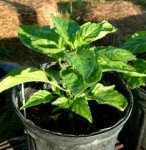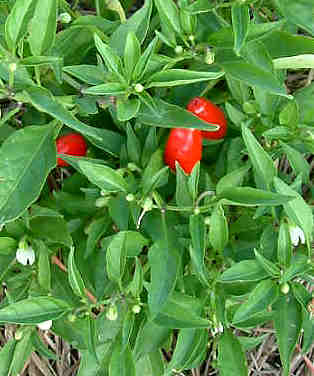Bhut Jolokia – The World’s Hottest Pepper
Bhut Jolokia is the reigning world’s hottest pepper. The most pungent tested over 1,000,000 Scoville Units. That’s beyond hot!
I decided to grow some jolokia in my garden, along with some mustard habanero and some scotch bonnet peppers. The ultimate comparison should be quite interesting!
About Bhut Jolokia
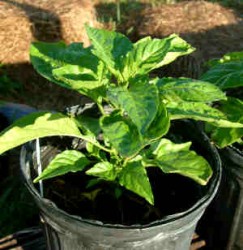 This nuclear-heat chile pepper is known by several names. In addition to Bhut Jolokia, it’s also known as Naga Jolokia, Nai Miris, Ghost Chili, Ghost Pepper and Naga Morich. Yes, it’s a little confusing (to say the least).
This nuclear-heat chile pepper is known by several names. In addition to Bhut Jolokia, it’s also known as Naga Jolokia, Nai Miris, Ghost Chili, Ghost Pepper and Naga Morich. Yes, it’s a little confusing (to say the least).
This chile pepper comes from the Indian sub-continent, and thought to have originated in Northeast India, in Nagaland.
There’s been some controversy over this pepper; some say that the testing (done by 3 different labs) was hoaxed and nothing could top 1 million Scoville. But, the Chile Pepper Institute, run by New Mexico State University, ran tests in 2005 and yes, it was over 1,000,000 Scoville.
In February 2007, Guinness World Records certified the Bhut Jolokia (Prof. Bosland’s of the Chile Pepper Institute’s preferred name for the pepper) as the world’s hottest chili pepper.
There’s a question if the jolokia pepper is a member of the capsicum chinense or capsicum frutenscens family. I’m going to go with c. chinense, because the plant looks very similar to the Mustard Habanero plant I am growing in a different part of the garden.Â
(You can read read my pepper types post for more information on the different species.)
Growing Bhut Jolokia
The seeds aren’t exactly cheap (I paid about $1 per seed), and I started 2 seeds. Both sprouted, but one was felled by (I assume) the weather. The other one is doing beautifully!
The photo above is about a week before I planted it in my new raised bed garden. Since it’s been in the raised bed it has flourished and is a beautiful plant. It’s just now starting to form some flower buds, and before the buds open, I am going to bag the blossoms, so I can be sure of having more seeds going forward.
I’ll be posting more about Bhut Jolokia, the world’s hottest pepper, in the future, especially once the peppers start to form. And it will be quite interesting to compare it against my Mustard Habanero and Scotch Bonnet Early peppers.
Stay tuned!
Growing Thai Hot Peppers
Growing Thai Hot Peppers means you’re growing a delight.  The low-growing plant blossoms profusely and produces a bounty of bright red peppers, pointing upwards.
A Little About the Peppers
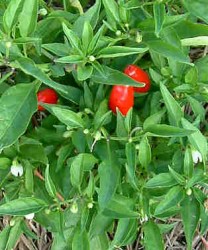 Thai Hot is equally at home in a container or in the ground. A three-gallon container will suit this pretty little pepper just fine. You might even be able to get away with a 1-gallon container, if you keep it well-watered and fertilized.
Thai Hot is equally at home in a container or in the ground. A three-gallon container will suit this pretty little pepper just fine. You might even be able to get away with a 1-gallon container, if you keep it well-watered and fertilized.
I have the plant in the photo (and by the way, you can click on the photo to see a larger picture) growing in the ground, and it’s about 8-inches tall. It’s also spread about 7 inches in diameter.
Now in the photo you only see 3 red peppers, but see all those blossoms and blossom buds? In a couple of weeks, the plant will be covered with peppers.
Can You Eat the Peppers?
Sure you can, but be warned –they aren’t called “Thai Hot” for nothing! One chopped pepper (with seeds) can easily season a large bowl of chili.
Speaking of the peppers, they are only about 3/4″ tall. They aren’t large, but they are potent.
But the charm of these peppers is ornamental. They make a great garden border, looking like bright red flowers. And of course, you could each day pick a few of the peppers in the border and you’d never see a difference.
Growing Thai Hot Peppers
My pepper plant survived some very chilly weather early this season, with temperatures down in the 30’s. It was a little sad-looking until the cold weather passed, but then came back admirably.
As with all chile peppers, they like warm weather and plenty of sunshine. I mentioned that you can grow these in containers easily, and Thai Hot could certainly be grown indoors under lights.
An an FYI, there is a larger variety, called Giant Thai Hot. I haven’t tried it yet, but the peppers get to about 2″ long, instead of the normal 1/2 to 3/4 inches. There’s also a version that has orange peppers instead of red.
Growing Banana Peppers
Growing banana peppers is really easy, as they are one of the most forgiving varieties. Still, they do need some care. Let’s take a look at growing banana peppers in the garden.
Type of Banana Peppers
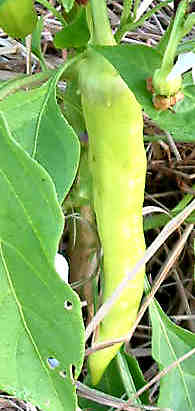 These versatile veggies go by several names, but they can be divided into two main types:Â sweet banana peppers and hot banana peppers.
These versatile veggies go by several names, but they can be divided into two main types:Â sweet banana peppers and hot banana peppers.
The most common banana pepper is called Hungarian, and it’s also available both ways. So that’s something to keep in mind when you are perusing the seeds!
The hot variety of the banana pepper reaches around 3,500 to 4,000 Scoville Units — about on par with jalapenos.
Growing Banana Peppers in Containers
Sure, you can grow these peppers in containers. For a bountiful harvest, I suggest 5-gallon containers. However, with a good potting soil, plenty of fertilizer, water and sunshine, they can also be grown successfully in 3-gallon pots.
Here’s more detailed information about container pepper growing.
Peppers in the Garden
Peppers, including the bananas, have similar requirements to their relative the tomato. That includes a fertilizer that has more phosphorus (the middle number of the fertilizer content) than nitrogen. While a lot of nitrogen will grow you large, lush plants, you won’t get many peppers off it.
Peppers like rich, well-drained soil. I’ve found that they also appreciate “fluffy” soil, which doesn’t compact easily, but which holds enough water to keep the plant happy. I do this by incorporating compost, sphagnum moss and perlite in the planting hole and surrounding soil.
Peppers like warm weather, especially the hot varieties. They don’t appreciate a windy location, so if you do get really breezy on a regular basis, see about constructing a wind break of sorts.
What About Eating?
You can eat the banana peppers when they are immature (green), ripe (red) or anywhere in between!
Here’s a hint: a sweet pepper will grow sweeter the riper it gets. Similarly, a hot banana pepper will turn up the heat, the riper it is.
Enjoy growing (and eating) your banana peppers!
